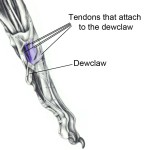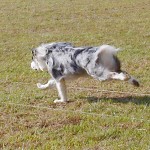Do the Dew(claws)?
M. Christine Zink DVM, PhD, DACVSMR
I work exclusively with canine athletes, developing rehabilitation programs for injured dogs or dogs that required surgery as a result of performance-related injuries. I have seen many dogs now, especially field trial/hunt test and agility dogs, that have had chronic carpal arthritis, frequently so severe that they have to be retired or at least carefully managed for the rest of their careers. Of the over 30 dogs I have seen with carpal arthritis, only one has had dewclaws.
If you look at an anatomy book (Miller’s Guide to the Anatomy of Dogs is an excellent one – see Figure 1 below) you will see that there are 5 tendons attached to the dewclaw. Of course, at the other end of a tendon is a muscle, and that means that if you cut off the dew claws, there are 5 muscle bundles that will become atrophied from disuse.
Those muscles indicate that the dewclaws have a function. That function is to prevent torque on the leg. Each time the foot lands on the ground, particularly when the dog is cantering or galloping (see Figure 2), the dewclaw is in touch with the ground. If the dog then needs to turn, the dewclaw digs into the ground to support the lower leg and prevent torque. If the dog doesn’t have a dewclaw, the leg twists. A lifetime of that and the result can be carpal arthritis, or perhaps injuries to other joints, such as the elbow, shoulder and toes. Remember: the dog is doing the activity regardless, and the pressures on the leg have to go somewhere.
Perhaps you are thinking, “None of my dogs have ever had carpal pain or arthritis.” Well, we need to remember that dogs, by their very nature, do not tell us about mild to moderate pain. If a dog was to be asked by an emergency room nurse to give the level of his pain on a scale from 0 o 10, with 10 being the worst, their scale would be 0, 0, 0, 0, 0, 6, 7, 8, 9, 10. Most of our dogs, especially if they deal with pain that is of gradual onset, just deal with it and don’t complain unless it is excruciating. But when I palpate the carpal joints of older dogs without dewclaws, I frequently can elicit pain with relatively minimal manipulation.
As to the possibility of injuries to dew claws. Most veterinarians will say that such injuries actually are not very common at all. And if they do occur, then they are dealt with like any other injury. In my opinion, it is far better to deal with an injury than to cut the dew claws off of all dogs “just in case.”
 Figure 1. Anatomical diagram viewing the medial
Figure 1. Anatomical diagram viewing the medial
side of a dog’s left front leg demonstrating the five
tendons that attach to the dewclaw.
–from Miller’s Guide to the Dissection of the Dog
 Figure 2. In this galloping dog, the dewclaw is in
Figure 2. In this galloping dog, the dewclaw is in
touch with the ground. If the dog then needs to turn
to the right, the dewclaw digs into the ground to
support the lower leg and prevent torque.
